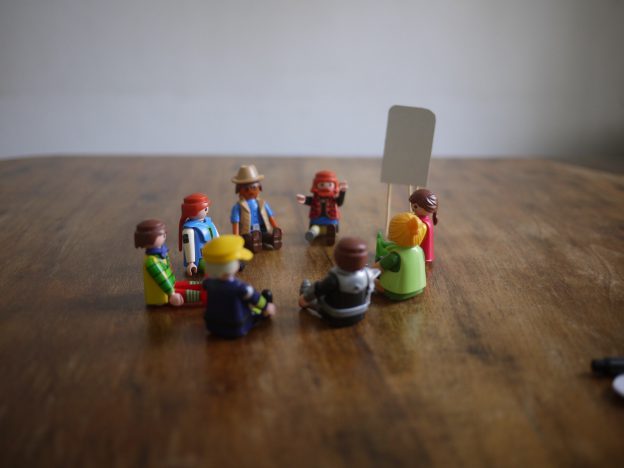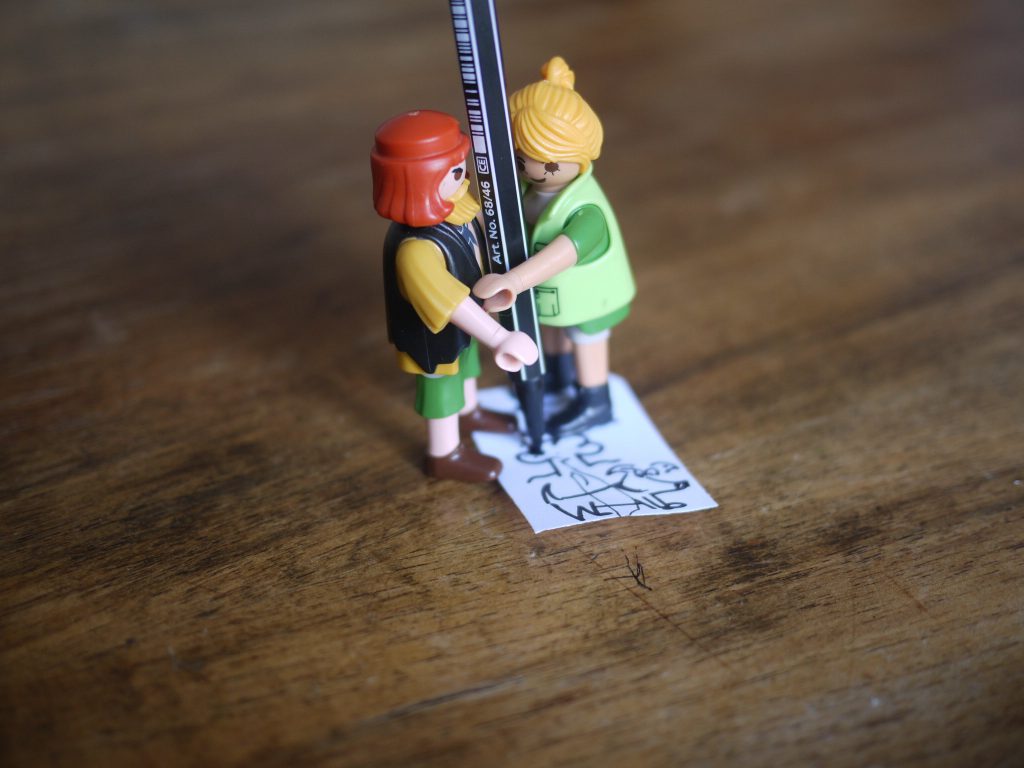
Today our five experts meet at Rudi’s practice. The rapid changes and partial lack of clarity about what is allowed where and how have made Maria, Yasemine, Rudi, Paul and Beate a little uncertain. That’s why everyone was happy when Rudi suggested meeting at his place. Sitting in a circle of chairs and provided with drinks and nibbles, they start talking.
Free, post and other cards
„So this is where you work most of the time?“ Beate asks Rudi. He nods affirmatively and explains the settings – group therapy, coaching and team supervision – for which he usually uses this room. „Yes, and sometimes smaller teams hold retreats here, like yesterday. Here is the box with the freecards,“ Rudi says, pointing to the corner next to the flipchart. Freecards are postcards with a wide variety of motives that are available for advertising purposes in pubs and event venues. Since our protagonists wanted to talk about the possibilities of visualisations in working with groups this time anyway, Rudi continues: „I’ve been collecting these cards for years and so I’ve built up a certain fund of cards that I like to use to support getting-to-know-you sessions or to introduce a topic. I usually make a pre-selection depending on the group/group culture and group size. I put the cards on a table or a cloth on the floor and ask all participants to choose a card.“
„This request is accompanied by different cues depending on the aim of the intervention. For example, if it is about arriving or getting to know someone, I ask them to pick a card that ’speaks to you right now‘ or that ’stands for an expectation of yours‘. As a starting point for working on a particular topic, questions such as ‚Pick a card that matches the feeling you have about this topic‘ or ‚The card should illustrate the importance of the topic for you‘ are appropriate. The question should be suitable for guiding you towards dealing with the topic.“
„At the moment I ask the participants to disinfect their hands beforehand and to step up to the card table one after the other. This is much less dynamic than if everyone makes their selection at the same time, but it has the quality that each person is in focus for a short time and the pace is slowed down. Otherwise, the cards can be divided among several tables.“ „And what happens to them then?“ asks Paul. „When everyone has found a card, everyone sits in a circle of chairs again and the participants take turns presenting their cards. When we get to know each other, I ask them to say the name, show and describe the card and tell why this particular card was chosen,“ Rudi answers. In addition to these freecards, there is a wide variety of picture cards that have been specially designed for the training sector.
We love flips!
„I was often so embarrassed by my flips! Still, it took many years of resolution before I finally attended a workshop where I learned how to make my flips better. And I think it paid off!“ reports Yasemine with a glance at the flipchart and a certain pride in her voice. Rudi’s question, „But isn’t it just a matter of practice?“ is answered unequivocally in the affirmative by Yasemine, „but practising is much more effective when I know what to look for. And also, all the tips and tricks I learned at the workshop were not only helpful, but I’ve also enjoyed preparing flips more since then.“
She went on to say that it takes a lot of effort and the prepared flips are also more beautiful than the ones created during a workshop. „But there has been an added effect: I usually prepare the first flips – for welcome, schedule, topics, work assignments – in the days before the event. I take around two hours to do this and create a trouble-free atmosphere. During this time, I not only design the flips, but also immerse myself in the content and atmosphere of the situation that awaits me. In the process, I also sense quite well if something is still missing in my preparation or doesn’t fit as well as assumed.„
Yasemine adds that deciding on the colours and style of the flips for the respective event and also writing the flip is much easier in the meantime. In addition, there is always positive feedback from participants, for whom it also expresses appreciation when someone takes on the work. Not to mention the likelihood that the photo protocol, which largely consists of photographed flips, will actually be looked at.
Paul also has an addition: „At REFAK there is a regular seminar called A picture is worth a thousand words, which is also about flipchart design. Since the seminar is always booked up very quickly, a blog series has even been started on it, the #visdo, which now contains over 30 posts with instructions on how to try it out.
Line-ups
The five briefly discuss whether a line-up is also a visualisation. Beate argues: „When I do line-ups with a group, I often say that it is to make something visible. Therefore I would already say that it is a visualisation.“ This also sounds coherent to the others and Maria asks Beate to describe the use of the method with a specific example. „I often do line-ups, especially when I work with groups or teams that are supposed to work together intensively in the future. I am convinced that cooperation works better when the individuals know about commonalities and differences in the group. Moreover, this also sets that both – similarities AND differences – have a place and are important and legitimate.“ Maria is a little impatient today and asks, „And what are you doing in more specific terms?“ Rudi supports the concretisation with the suggestion to apply the method here and now. The colleagues are briefly surprised, but at the same time curious to use their meeting to try out methods.
Maria agrees to guide the exercise, but at the same time she wants to participate. She would never do that in a professional setting, but in this setting she thinks it is feasible and draws up the following assignment: Each person should think of a criterion for similarities and differences that could be relevant in their group and write this criterion down. „What do you mean exactly?“ asks Paul. „For example, if we were a group of cobblers or shoe sellers, our shoe sizes could be relevant. But since we have different professional backgrounds, and our meetings have specific goals, other things are probably more relevant, like how much experience we have working with groups or something like that.“ „Yes, of course,“ Paul exclaims, „or also how important it is for us to exchange with each other!“
Each person thinks about it and writes down a criterion on a piece of paper. As Beate reads through the notes, she notices that the same criterion has been written down twice. „That almost always happens and that’s why it’s important to take that into account. If it is not quite clear what is meant – for example, a group has written down experience – we clarify again together what it is specifically about, i.e. life experience or work experience, for example. Once this has been clarified, it is easier to decide how to line-up. Sometimes scaling, small groups or even positioning to a centre point are suitable.“ For the next 20 minutes, the five use the space available to them and make the criteria visible. After the differentiation exercise, they exchange ideas about other line-ups, also with objects or moderation cards.
The five „group workers“ enjoyed the practical experience and agreed to make experimental settings and methods in working with groups the topic of their next meeting!
Authors: Gerda Kolb and Irene Zavarsky
Lust auf mehr? Zu allen Beiträgen der Serie kommst du HIER!

Dieses Werk ist lizenziert unter einer Creative Commons Namensnennung-NichtKommerziell-Weitergabe unter gleichen Bedingungen unter gleichen Bedingungen 3.0 Österreich Lizenz.
Volltext der Lizenz



